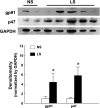Impaired flow-induced dilation of coronary arterioles of dogs fed a low-salt diet: roles of ANG II, PKC, and NAD(P)H oxidase
- PMID: 20833958
- PMCID: PMC2993196
- DOI: 10.1152/ajpheart.01250.2009
Impaired flow-induced dilation of coronary arterioles of dogs fed a low-salt diet: roles of ANG II, PKC, and NAD(P)H oxidase
Abstract
Low-salt (LS) diet has been considered to be beneficial in the prevention and treatment of hypertension; however, it also increases plasma angiotensin (ANG) II and may cause adverse cardiovascular effects, such as endothelial dysfunction. We assessed endothelial function of coronary arterioles and vascular superoxide production, as a function of LS diet. Dogs were fed with LS (0.05% NaCl) or a normal-salt (NS, 0.65% NaCl) diet for 2 wk. There were threefold increases in plasma ANG II, associated with a 60% reduction in flow-induced dilation (FID) in coronary arterioles of LS compared with NS dogs. In vessels of NS dogs, FID was primarily mediated by nitric oxide (NO), as indicated by an eliminated FID by N(ω)-nitro-l-arginine methyl ester (l-NAME). In vessels of LS dogs, however, FID was eliminated. Administration of apocynin, a NAD(P)H oxidase inhibitor, partially restored FID and additional l-NAME eliminated FID. Generation of superoxide, measured with dihydroethidium, was significantly greater in vessels of LS than in NS dogs, which was further increased in response to ANG II or phorbol 12,13-dibutyrate, an agonist of protein kinase C (PKC). The enhanced superoxide was normalized by apocynin, losartan (a blocker of angiotensin type 1 receptor), and chelerythrine chloride (an antagonist of PKC). Western blotting indicated an upregulation of gp91(phox) and p47(phox), associated with increased expression of phosphorylated PKC in vessels of LS dogs. In separate experiments, dogs were fed simultaneously with LS and losartan (LS + Losa) for 2 wk. There was a significant increase in plasma ANG II in LS + Losa dogs, which, however, was associated with normal FID and gp91(phox) expression in coronary arterioles. In conclusion, LS led to endothelial dysfunction, as indicated by an impaired flow-induced dilation caused by decreasing NO bioavailibility, a response that involves angiotensin-induced activation of PKC that, in turn, activates vascular NAD(P)H oxidase to produce superoxide.
Figures






Similar articles
-
Divergent roles of angiotensin II AT1 and AT2 receptors in modulating coronary microvascular function.Circ Res. 2003 Feb 21;92(3):322-9. doi: 10.1161/01.res.0000056759.53828.2c. Circ Res. 2003. PMID: 12595345
-
Effects of angiotensin II infusion on the expression and function of NAD(P)H oxidase and components of nitric oxide/cGMP signaling.Circ Res. 2002 Mar 8;90(4):E58-65. doi: 10.1161/01.res.0000012569.55432.02. Circ Res. 2002. PMID: 11884382
-
Angiotensin-(1-7) and low-dose angiotensin II infusion reverse salt-induced endothelial dysfunction via different mechanisms in rat middle cerebral arteries.Am J Physiol Heart Circ Physiol. 2010 Oct;299(4):H1024-33. doi: 10.1152/ajpheart.00328.2010. Epub 2010 Jul 23. Am J Physiol Heart Circ Physiol. 2010. PMID: 20656887 Free PMC article.
-
ADMA impairs nitric oxide-mediated arteriolar function due to increased superoxide production by angiotensin II-NAD(P)H oxidase pathway.Hypertension. 2008 Nov;52(5):960-6. doi: 10.1161/HYPERTENSIONAHA.108.116731. Epub 2008 Oct 6. Hypertension. 2008. PMID: 18838625
-
Cardiovascular effects of losartan and its relevant clinical application.Curr Med Chem. 2009;16(29):3841-57. doi: 10.2174/092986709789178046. Curr Med Chem. 2009. PMID: 19747137 Free PMC article. Review.
Cited by
-
Endothelin-1 impairs coronary arteriolar dilation: Role of p38 kinase-mediated superoxide production from NADPH oxidase.J Mol Cell Cardiol. 2015 Sep;86:75-84. doi: 10.1016/j.yjmcc.2015.07.014. Epub 2015 Jul 23. J Mol Cell Cardiol. 2015. PMID: 26211713 Free PMC article.
-
Vascular TRP channels: performing under pressure and going with the flow.Physiology (Bethesda). 2014 Sep;29(5):343-60. doi: 10.1152/physiol.00009.2014. Physiology (Bethesda). 2014. PMID: 25180264 Free PMC article. Review.
-
CYP2C29 produces superoxide in response to shear stress.Microcirculation. 2012 Nov;19(8):696-704. doi: 10.1111/j.1549-8719.2012.00202.x. Microcirculation. 2012. PMID: 22708815 Free PMC article.
-
Loss of renal medullary endothelin B receptor function during salt deprivation is regulated by angiotensin II.Am J Physiol Renal Physiol. 2012 Sep;303(5):F659-66. doi: 10.1152/ajprenal.00213.2012. Epub 2012 Jun 6. Am J Physiol Renal Physiol. 2012. PMID: 22674027 Free PMC article.
-
Reduced angiotensin II levels cause generalized vascular dysfunction via oxidant stress in hamster cheek pouch arterioles.Microvasc Res. 2013 Sep;89:134-45. doi: 10.1016/j.mvr.2013.04.004. Epub 2013 Apr 27. Microvasc Res. 2013. PMID: 23628292 Free PMC article.
References
-
- Ago T, Kitazono T, Ooboshi H, Iyama T, Han YH, Takada J, Wakisaka M, Ibayashi S, Utsumi H, Iida M. Nox4 as the major catalytic component of an endothelial NAD(P)H oxidase. Circulation 109: 227– 233, 2004 - PubMed
-
- Alderman MH. Salt, blood pressure, and human health. Hypertension 36: 890– 893, 2000 - PubMed
-
- Alderman MH, Cohen H, Madhavan S. Dietary sodium intake and mortality: the National Health and Nutrition Examination Survey (NHANES I). Lancet 351: 781– 785, 1998 - PubMed
-
- Babior BM. NADPH oxidase. Curr Opin Immunol 16: 42– 47, 2004 - PubMed
-
- Babior BM, Lambeth JD, Nauseef W. The neutrophil NADPH oxidase. Arch Biochem Biophys 397: 342– 344, 2002 - PubMed
Publication types
MeSH terms
Substances
Grants and funding
LinkOut - more resources
Full Text Sources
Medical
Miscellaneous

